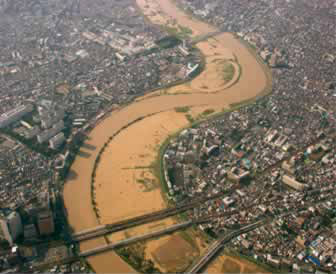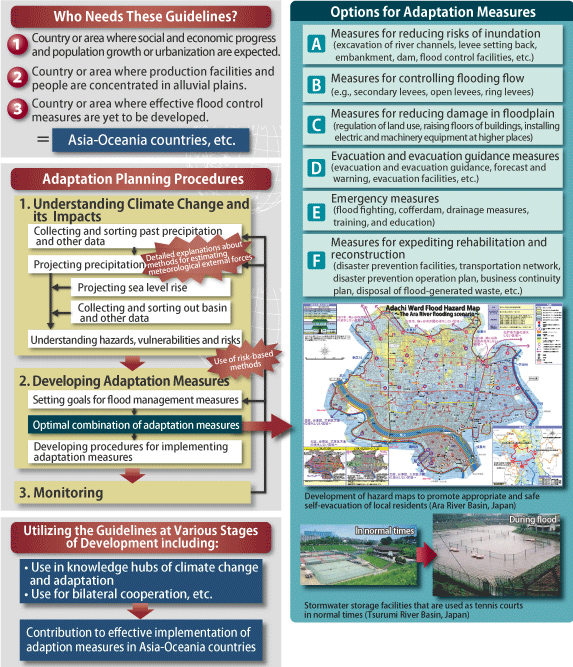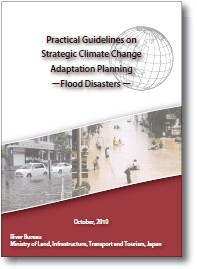|
Activity
for Climate Change
It has been pointed out that global climate change is likely to cause rising
sea level and enlarged fluctuations of precipitation including more frequent
heavy rainfall, more intensified tropical cyclones and severer droughts. To
cope with these possible future changes, the River Bureau of the Ministry of
Land, Infrastructure, Transport and Tourism, Japan, is currently looking into
how Japan should implement adaptation measures to climate change especially
in the field of water-related disasters, such as floods, sediment-related
disasters, storm surges and droughts.

●Climate Change Adaptation Strategies to Cope with Water-related
Disasters due to Global Warming
Policy Report (June 2008)
(PDF 330KB)
Reference material (PDF 7.54MB)
Development of Practical Guidelines on
Strategic Climate Change Adaptation Planning
−Flood Disasters−
The Ministry of Land, Infrastructure, Transport and Tourism of Japan has developed a manual of basic procedures for deciding on adaptation measures to cope with increasing flood risks caused by climate change.
This manual is based on the experience, strategiesand technology accumulatedover the years in Japan.
- Title: Practical Guidelines on Strategic Climate Change Adaptation Planning —Flood Disasters—
- Author: River Bureau, Ministry of Land, Infrastructure,Transport and Tourism, Japan
- Number of pages: 58 (A4 size)
- Published in: October, 2010
This manual can be used to develop adaptation measures in
Asia-Oceania countries, etc.
For use by
Practitioners of river and water resources management
responsible for developing concrete adaptation plans.
(Features)
- River basin-based planning
- Detailed explanations of methods for estimating meteorological external forces such as precipitation that are important for the adaptation to climate change
- Setting goals and selecting a combination of concrete adaptation measures based on hazard, vulnerability and risk assessment
Impacts of climate change are strongly reflected in changes in precipitation and sea level, which are external forces against which flood damage mitigation measures are to be taken.
Consequently, additional damage resulting from "no action" for flood damage mitigation is likely to increase considerably.
Although adaptation measures should be designed taking into consideration overall environmental impacts including impacts on food and forests, these guidelines give priority to measures to be taken to maintain safety from floods, which are the greatest threats in the Asia- Oceania countries.

Japan Practical Guidelines on Strategic Climate ChangeAdaptation Planning
−Flood Disasters−(ENG) (PDF 37.8MB)
Japan Practical Guidelines on Strategic Climate ChangeAdaptation Planning
−Flood Disasters−(JPN) (PDF 39.0MB)
Practical Guideline on
Strategic Climate Change Adaptation Planning (brochure) (PDF 987KB)
|


